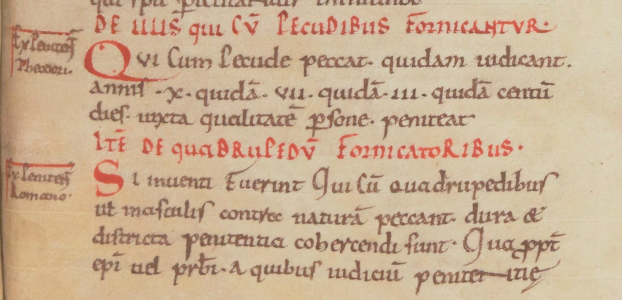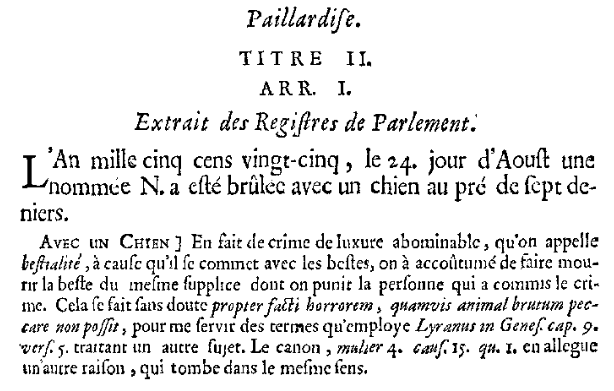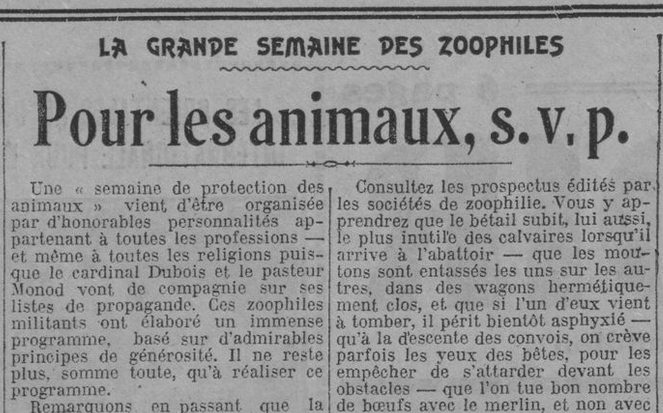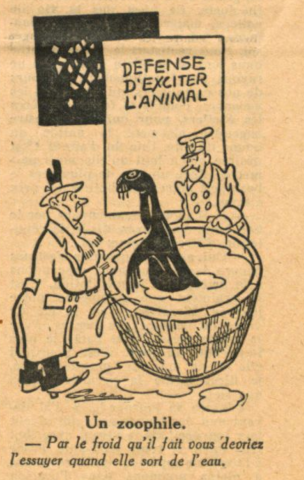In all texts dealing with zoosexuality, you’re bombarded with definitions. Today, we mostly talk about bestiality, zoophilia and zoosexuality. But did you know that all these words have in fact meant the same thing during different historical periods? These terminological distinctions allow us to identify historical periods with their own mores. We have identified five such periods: Christianity, speciesism, animal protection, psychiatry and zoosexual liberation.
This article is based on research carried out in France. The following comments are therefore not universal.
Christianity
In ancient texts, zoosexuality is referred to by means of periphrases. In Latin texts, for example, we find: “fornicationem contra naturam” (fornication against nature), “cum animalibus coires” (copulating with animals) or “cum quadrupedus peccat” (sinning with quadrupeds), and so on.
 (Figure 1: Decretum by Burchard of Worms, 1051, Pecudibus fornicantur / Quadrupedus fornicatoribus)
(Figure 1: Decretum by Burchard of Worms, 1051, Pecudibus fornicantur / Quadrupedus fornicatoribus)
It would appear that no word for zoosexuality existed until the 12th century, when the word sodomite came into widespread use. The latter refers to the Sodomites, inhabitants of the city of Sodom (Genesis 10:19). It is therefore an antonomasia (a proper noun turned into a common noun). According to the biblical account, an inhabitant of Sodom named Lot grants hospitality to two angels sent by God. All the men of Sodom then surrounded his house and asked Lot to bring out these strangers the people of the town thought were men, in order to “know” them (Genesis 19:05). To know in the biblical sense means to have a carnal relationships. Lot refuses and offers them two of his virgin daughters in exchange. The Sodomites decline, and God destroys the city with “a rain of sulfur and fire” (Genesis 19:24). Although there is some doubt as to the interpretation of the refusal of hospitality, biblically, the Sodomites are clearly male homosexuals. By extension, sodomy designates any type of sexual practice (hyperonym) said to be unnatural (non-procreative), a fortiori including zoosexuality.
There’s still the word bugger, a synonym for sodomite tinged with heresy. This word refers to the Bulgarian priest Bogomil, founder of Bogomilism. In the 13th century, under the influence of inquisitorial propaganda directed against the Bogomil heresy, buggers (Bulgarians) were branded sodomites. This appellation of “bugger” was purely due to infamy, since the Bogomils practiced asceticism (including sexual abstinence).
Speciesism
The word bestiality first appeared in the 14th century. It comes from the Latin “bestia” and refers to any behavior that likens man to a beast. This definition begs the question: how is a beast supposed to behave? For humans, a beast is a primitive being essentially characterized by its ferocity (bestiality) and stupidity (beastliness). And indeed, in its natural habitat, a hungry wild beast won’t say hello to you before trying to eat you. But are they any more ferocious than man? The beast is thus a referent of human imbalance; bestial has come to designate the criminal, the madman or the torturer.
The word bestiality acquired a second, sexual meaning in the 16th century.
 (Figure 2: 1525, Notable rulings by the parliament of Toulouse, “As a crime of abominable lust called bestiality[…]”.)
(Figure 2: 1525, Notable rulings by the parliament of Toulouse, “As a crime of abominable lust called bestiality[…]”.)
This “sexual bestiality” is a metaphorical figurative derived from the original meaning of the word; zoosexuality would be regressive, because it is directed towards the animal. Bestiality is therefore speciesism, including sexual speciesism.
Dilemma: between an unbalanced human and a willing animal, which sexual partner would you choose? When our contemporary sexologists speak of bestiality, they are referring directly to this brutal, stupid and primitive zoosexuality; to put it simply, this zoosexuality without love.
Animal Protection
The 19th century saw the birth of the word zoophilia. Its meaning at the time was simply that of its etymology: an affection (philia) for living things (zoo). The first French occurrences of the word coincided with article 453 of the Napoleonic Penal Code of 1810. But the word didn’t really spread until the 1820s. It can be linked to the creation of the London Zoo in 1828, or to Martin’s Act of 1822, an Anglo-Saxon law now considered the first animal protection law in the West. After Martin’s Act, French newspapers spoke of the “zoophilia of the English.” Obviously, a zoophile was seen as someone who condemned animal abuse. An animal protection society is called a “zoophilia society” or a “zoophile club”!
 (Figure 3: Newspaper article “The great week of zoophiles / For animals, please.” from Botrot, 1926)
(Figure 3: Newspaper article “The great week of zoophiles / For animals, please.” from Botrot, 1926)
A breeder is zoophilic if he takes care of his animals by applying, for example, this “zoophilic ointment” then on sale in the shops.
 (Figure 4:Celnart’s book “Zoophile manual”, 1827.)
(Figure 4:Celnart’s book “Zoophile manual”, 1827.)
 (Figure 5:Advertising for a “Zoophilic ointment” from Peyrat firm, 1868.)
(Figure 5:Advertising for a “Zoophilic ointment” from Peyrat firm, 1868.)
Little by little, zoophiles were ridiculed for their excessive love of animals. Zoophilia thus took on a negative connotation. This shift is potentially misogynistic, since as Féré notes, zoophilia is mainly found in women (1897, Zoophilie et zoophobie, Charles Féré). Whereas typically bestiality is mainly found in men.
 (Figure 6:The zoophile mockery, 1935, “Do not excite the animal / A zoophile / In this cold weather, you should wipe it off when it (she) comes out of the water.”)
(Figure 6:The zoophile mockery, 1935, “Do not excite the animal / A zoophile / In this cold weather, you should wipe it off when it (she) comes out of the water.”)
Psychiatry
The word “zoophilia” is said to have first appeared in a protosexual sense in the 8th edition of 1893: “Following on from material fetishism, we still have to think of certain cases where animals have an aphrodisiac effect on humans. One could speak here of erotic zoophilia.”
 (Figure 7: Krafft Ebing, 9th edition of Psychopathia Sexualis, “Zoophilia erotica”)
(Figure 7: Krafft Ebing, 9th edition of Psychopathia Sexualis, “Zoophilia erotica”)
The case associated with “thierfetischismus” is that of an adolescent sexually aroused by contact with animal fur (Die krankhaften Erscheinungen des Geschlechtssinnes, Tarnowsky, 1886). In psychiatric circles, zoophilia became sexual. But it was only after the war that the word zoophilia gradually replaced bestiality (probably under Anglo-Saxon influence). Ironically, the zoophiles of yesterday condemn those of today! Through the influence of psychiatry, zoophilia acquired a pathological connotation that it still retains today.
Krafft-Ebing proposed the word “zooerastie” as a category in his classification, with the meaning of pathological bestiality. The word was never widely used.
Clifford Allen coined the term bestiosexualité (The Sexual Perversions and Abnormalities, Clifford Allen, 1940). This word was also little used in France. It is cited only to highlight the existence of a word that predates “zoosexuality” based on the same “sexual” root.
Zoosexual liberation
The term “zoosexuality” was coined in the early 1990s by American practitioners (formerly zoophiles) on the Internet.
It’s easy to understand the reasons that led these zoosexuals to this linguistic protrusion: no word had ever exclusively described zoosexual reality. As we’ve seen, “sodomite”, “bugger”, “bestiality” and “zoophilia” are polysemous, so they can’t exclusively describe the act. What’s more, they have negative connotations: the sodomite is a sinner, the bugger a heretic, the bestial a brute, the zoophile a mental case! For its proponents, the word “zoosexuality” would be the missing word capable of naming an interspecies practice devoid of negative connotations.
The eternal question then arises. Which word to use? Zoophile or zoosexual? Both have their advantages and disadvantages.
The word “zoophile” is simple, understandable, has positive semantics and is suitable for everyone, including platonics. But it has a psychiatric connotation, and has been taken up by those wishing to import the “anti-contact” movement of pedophile origin to zoosexuality.
The word “zoosexual” emphasizes sexuality rather than affection. Effective in combating the anti-contact movement. Some experts have included sadism in zoosexuality. And as a final argument, zoosexuality is a clone of the word homosexuality, purposely chosen in the hope of one day being at the same level of societal tolerance as homosexuals. The word “zoosexual” thus embodies this idea of intervention in reality through language. Let’s reverse this logic. Does the word zoophile constitute an obstacle to a possible normalization process? We think not. For example, the French militant magazine Arcadie (1954–1982) called itself “homophile.” This in no way prevented the normalization of homosexuality, and in fact prefigured it.
Today, the word zoophilia is still very present; the word zoosexual has not taken hold. In this linguistic mess, diminutives thrive: zoo (noun), and zooey (adjective) (thanks to the Zooier Than Thou podcast). Word choice is important, but it’s not everything. Zoosexual liberation will first and foremost involve the fight against societal amalgams.
Article written by Chienlit (October 2023)
Images from Gallica (Figure 1), Tolosana (Figure 2) and RetroNews (Figure 3, 4, 5, 6).

